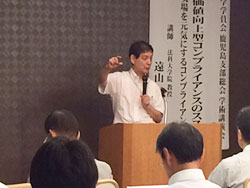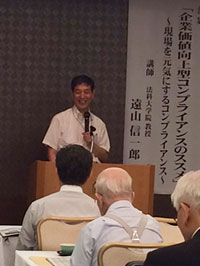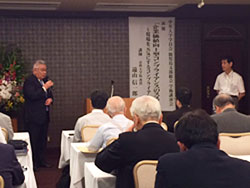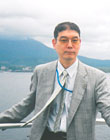Top>Research>Happiness Equation for Workers ―From the Perspective of Compliance for Increasing Corporate Value―
 Index
Index
Happiness Equation for Workers
―From the Perspective of Compliance for Increasing Corporate Value―
Shinichiro Toyama
Member of Daiichi Tokyo Bar Association
Professor, Chuo Law School
Areas of Specialization: Corporate Compliance, Modern Contract Law, Tort and Compensation Law (traffic accidents, medical malpractice, nuclear accidents, etc.), Domestic Relations Case Procedure Act, Labor Law, Insolvency Proceeding Law, Financial Legal Affairs, Antitrust Law, Personal Information Protection Law, Alternative Dispute Resolution (ADR), Legal Economics
This work was supported by JSPS KAKENHI Grant Number 15K03220. (Public Relations Office)
1. Happiness equation―What is happiness?

Suppose that personal happiness is defined as peace of mind and spiritual fulfillment. An equation for achieving happiness is as follows:
| Happiness (H) = | Wealth (W) |
| Desire (D) |
In this equation, the term of wealth encompasses a variety of concepts such as personal health, family health, income/assets, suitable occupation, and good human relationships (social capital).
Levels of desire range from a basic level (1) of feeling satisfied to a maximum level (10) of greed (craving).
During life, people spend the most time at their home and workplace. The home and workplace are main stages for exercising the universal right to the pursuit of happiness which is guaranteed by the Constitution of Japan.
Article 13 of the Constitution of Japan
All of the people shall be respected as individuals. Their right to life, liberty, and the pursuit of happiness shall, to the extent that it does not interfere with the public welfare, be the supreme consideration in legislation and in other governmental affairs.
A work-life balance (referred to as a “life-work balance” by some advocates) is a policy intended to support exercising the right to the pursuit of happiness.
Article 3-3 of the Labor Contracts Act
A labor contract is to be concluded or changed between a Worker and an Employer while giving consideration to work-life balance.
2. Synergy between happiness felt by workers and improving productivity/performance at corporations

From the perspective of psychology and sociology, the positive effects of a high feeling of happiness include high creativity, efficiency, productivity, respect for different opinions, altruism, good health, and long life.
From the perspective of economics, as for the workers who engage in work which helps others (altruism) while using the freedom to make personal judgments (emotional leeway) in order to achieve personal ideas and abilities (self-realization), they contribute to increased productivity and business performance at corporations. At the same time, workers themselves are able to feel happiness through aspects such as the sense of high achievement, recognition for good results, and promotions.
A famous example frequently discussed in economic texts is the 15% rule used by 3M Company (USA). This rule of emotional leeway allows 3M employees to spend 15% of their work time on experimental projects of their own choice without the need to receive approval from the company. The emotional leeway created by this rule succeeded in giving birth to the hit product Post-it®.
3. From the perspective of compliance for increasing corporate value

Corporate compliance can be considered from two approaches: compliance for risk management and compliance for increasing corporate value.
Compliance for risk management is mainly intended to prevent corporate scandals by ensuring that the corporation complies with laws, etc. In contrast, compliance for increasing corporate value goes beyond this main intention of risk management and aims to increase corporate value. This approach consists of behavior that responds to the rational requests of a variety of stakeholders of the corporation.
These two approaches are not in a conflicting relationship; rather, they are in a relationship of historical development within corporate compliance.
The starting point is “compliance = compliance with laws.” In this case, laws refer to what are known as hard laws; specifically, acts, orders, regulations, ordinances, etc.
In conjunction with changes in social conditions and needs of the era, the target of compliance shifts from laws to laws, etc., expanding the scope to soft laws which include internal rules, contracts, covenants, corporate ethics, etc.
These are about compliance for risk management, which has tended to morph into fatigue-type compliance due to excessive regulations and complicated procedures.
Furthermore, compliance for increasing corporate value functions as an operation management system which enables balanced response by the corporation to social requests that are the conglomerate of various rational expectations/requests from corporate stakeholders (representative examples are shareholders and workers). In this respect, compliance for increasing corporate value seeks to invigorate the corporation.
It is natural for corporations to comply with labor laws (group of laws related to labor; based on the Labor Standards Act, Labor Contracts Act, Labor Union Act, etc.) and to engage in compliance with labor law for avoiding reputation risk such as being labeled as a corporation that engages in unfair labor practices which make workers unhappy. Accordingly, society expects corporations to exceed this level and to engage in compliance management for amplifying the happiness of workers, improving corporate productivity, and increasing business performance.
The Action Plan for the Realization of Work Style Reform (March 28, 2017), a government growth strategy, defines a variety of issues such as the following:
①Alleviation of unreasonable disparities in treatment (labor disparities) among full-time employees and non-regular employees (Guidelines for Equal Pay for Equal Work, etc.)
②Correction of prolonged working hours through implementation of penal restrictions on maximum overtime
③Development of an environment to facilitate flexible working styles such as telecommuting, etc.
④Balance working and treatment of illness
⑤Balance working and child-raising/nursing care, etc.
Specific initiatives for addressing these issues can be understood and evaluated as measures for supporting compliance for increasing corporate value.
4. Hope equation for employment society

How can an employment society be constructed where workers who are currently unhappy could have hope for happiness?
Today, Japanese society is facing structural expansion of a declining birthrate, aging population, and social disparity. In this society, each laborer (L) works to develop their skills and advance their career while seeking to maintain a work-life balance without becoming parasitic to their corporation. The employer (corporation) (E) supports these efforts through compliance management for increasing corporate value. The government (G) formulates and implements policy for developing a working environment and creating specific rules between workers and management to serve as a basis for labor-management relations.
This structure can be expressed by the following equation for hope in employment society of Japan.
H = L x E x G
References
- Takashi Oshio Deciding Factors for Happiness—Economics of Objective Social Welfare, 2014, Nikkei Publishing Inc.
- Toshiaki Tachibanaki The Economics of Happiness, 2013, Iwanami Shoten, Publishers
- Fumio Otake et al. Happiness in Japan—Social Disparity, Labor, and Family, 2010, Nippon Hyoron Sha Co., Ltd.
- Yuji Genda How to Create Hope, 2010, Iwanami Shoten, Publishers
- The Two Basic Laws of Life—Family Law and Labor Law

- Classroom Scene—Law School and Business School

- Shinichiro Toyama
Member of Daiichi Tokyo Bar Association
Professor, Chuo Law School
- After graduating from the Department of Law in the Chuo University Faculty of Law in 1975, Shinichiro Toyama became a Specially Appointed Professor in the Chuo Law School in 2004. He has served as Professor in the Chuo Law School since 2014 to the present.
His major public positions include a member of a special committee of the Dispute Reconciliation Committee for Nuclear Damage Compensation of the Ministry of Education, Culture, Sports, Science and Technology; a member of a special committee of the Dispute Reconciliation Committee of Construction Work of the Ministry of Land, Infrastructure, Transport and Tourism; an outside expert for Inspection Department of Minister’s Secretariat of the Ministry of Agriculture, Forestry and Fisheries; a member of the Civil Conciliation Commissioners of the Supreme Court of Japan; a medical ADR arbitrator for the Tokyo San Bengoshikai and more.
His main publications and articles include Antitrust Law Useful for Daily Living, The World of Traffic Accident Civil Liability: Theory and Practice, Resolution of Individual Labor Disputes, Child Welfare and Joint Custody, JA Compliance: Creating a System for Preventing Misconduct, Construction Process Theory of the Corporate Value Improvement Type Compliance Preparation Model and more.
He serves as Research Director for the Grants-in-Aid for Scientific Research (JSPS KAKENHI Grant Number 15K03220).
- Research Activities as a Member of Research Fellowship for Young Scientists (DC1), Japan Society for the Promotion of Science (JSPS) Shuma Tsurumi
- Important Factors for Innovation in Payment Services Nobuhiko Sugiura
- Beyond the Concepts of Fellow Citizens and Foreigners— To Achieve SDGs Goal 10 “Reduce Inequality Within and Among Countries” Rika Lee
- Diary of Struggles in Cambodia Fumie Fukuoka
- How Can We Measure Learning Ability?
—Analysis of a Competency Self-Assessment Questionnaire— Yu Saito / Yoko Neha - The Making of the Movie Kirakira Megane









